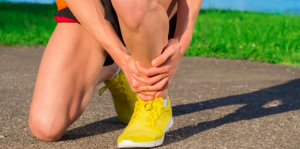What causes anterior ankle impingement?
Anterior ankle impingement is caused by either trauma/injury or repetitive compressive forces on the structures at the front of the ankle. This compression occurs on movements that dorsiflex the foot, or point the foot upwards on the ankle. It may be an irregular bony shape at the anterior ankle that can make you prone to ankle impingement, a bony protrusion (called an osteophyte) at the anterior ankle or improper healing following an injury such as an ankle sprain. The resulting pinching and compression irritate the joint capsule and tissues and results in swelling and pain. This means that activities and sports that regularly point the foot upwards can lead to anterior ankle impingement, as well as one-off injuries. Contributing factors may include:
The resulting pinching and compression irritate the joint capsule and tissues and results in swelling and pain. This means that activities and sports that regularly point the foot upwards can lead to anterior ankle impingement, as well as one-off injuries. Contributing factors may include:
- Tripping/falling with the foot still flat on the ground
- Ankle sprains
- Squatting and jumping activities
- Running uphill
- Soccer that involves regular kicking of the ball
- Dancing
- Stiffness at the ankle joint
- Abnormal foot biomechanics
- Poor technique in running or other sports
What are the symptoms?
Symptoms can include:- Pain and tenderness at the front of the ankle
- Swelling
- Stiffness or weakness in the ankle joint
- Pain is exacerbated by pointing the toes upwards
How is it treated?
Treatment begins by minimising the painful symptoms by following the PRICE principles (protection, rest, ice, compression, elevation). The next step is to allow the damaged structures to heal and then to reduce the risk of re-injury. This may include:- Orthotics to control the movement of the foot, lift the heel to create a larger space at the anterior ankle and correct any biomechanical abnormalities present
- Footwear assessment to ensure that footwear is helping and not hindering recovery
- Stretching tight muscles that may have contributed to the injury
- Strengthening weakened muscles as a result of the injury or that may have contributed to the injury
- Gait retraining to work on proper technique and reduce the risk of future injury








